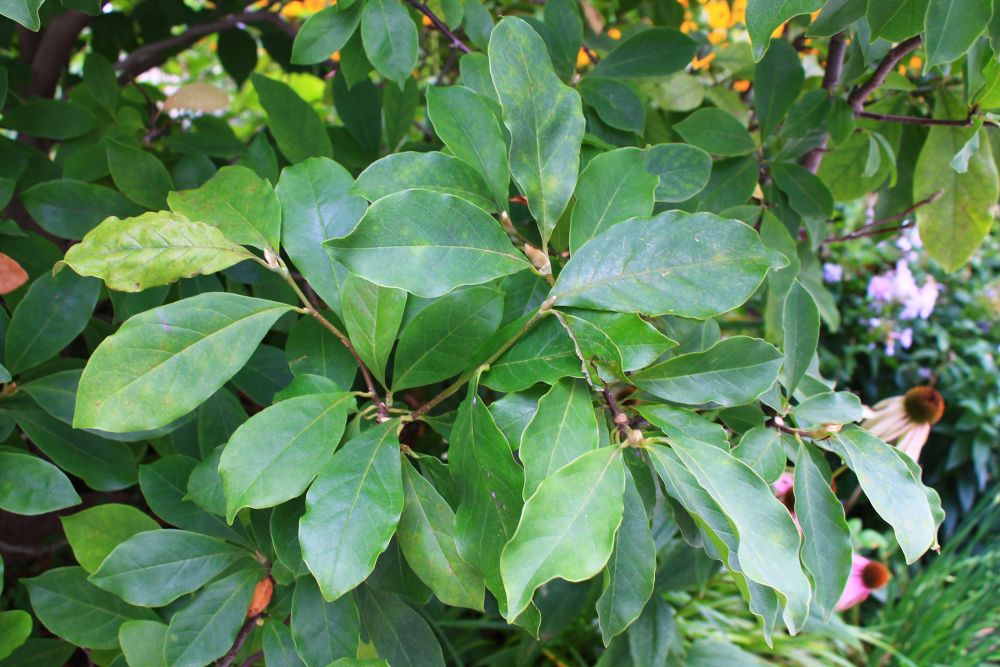
Tour leaders (from left) Angie Hutnick (York Region), Bronwen Fitzsimons (York Region Food Network), Melissa Williams (LEAF) and Jessica Yau (City of Markham).
The Old Markham Village Edible Tree Tour started out in a beautiful community garden on Maple Street run by the York Region Food Network. The garden contained 85 bountiful plots of vegetables including tomatoes, bok choy, kale, beans and more. We quickly set off on our tour, which was led by LEAF's own Melissa Williams, as well as Bronwen Fitzsimons from York Region Food Network, Angie Hutnick from York Region and Jessica Yau from the City of Markham. I was excited to keep a running count of the number of edible trees and shrubs that we would visit - my total count was 10 unique edibles, with various varieties to boot. The important question on everyone's mind as the tour progressed was, "What part of these trees can I eat?!"

Angie tells us about crabapple trees.
Here's a quick run-down of all that we saw - and all that you can eat:
- Black walnut tree: The nut of this tree can be consumed, though getting the meat out can be a bit tedious. This tree can be tapped just like a maple tree!
- Maple trees (Manitoba and sugar and Norway, oh my!): We saw lots of different maple trees on our walk, and of course the tasty part of this tree is the iconic syrup which can be tapped in the late winter
- Mulberry bush: The berries on mulberry bushes are ready to eat in late June, and come in red and white varieties.
- Crabapple tree: These trees produce the cutest little apples (must be 2 inches or smaller to be considered a crabapple) and these make the tastiest jelly or apple butter.

Magnolia Tree
- Magnolia tree: You will recognize these trees by the beautiful early spring blossoms, but did you know the pods of a magnolia tree can be eaten and have a horseradish type taste?
- Currant bush: The berries of this currant bush looked ripe and ready to eat - great in jams, jellies or thrown on top of a salad.

Gingko Tree
- Gingko tree: This tree bears fruit that smells not so nice (quite awful actually!) but the nuts inside are good to eat. Perhaps plug your nose while devouring the fleshy part so that you can enjoy.
- White pine tree: This tree's bark can be ground up into flour if you are in a pinch and its needles can be boiled into tea packed full of Vitamin A and C.
- Black locust tree: This tree bears showy white flowers in the early summer which can be eaten. They taste like sweet green peas, and their pink base is crunchy like celery.
- White oak tree: This tree has edible acorns that are ready in the fall. These acorns can be roasted and eaten, or ground down into a flour.

Samples from Forbes Wild Foods.
Our tour ended back at the York Region Food Network community garden where we were lucky enough to taste some treats generously donated by Forbes Wild Foods. We also learned more about the Markham Community Food Programs, including the Markham Organic Home Gardens Program, the Seed Library and of course the network of community gardens in York Region.
The city's heat alert for the day couldn't stop these Markham residents from getting out, enjoying the edibles and looking upward!
LEAF’s Tree Tours in York Region are supported by Ontario Power Generation's Biodiversity Program and York Region.
Stefani Pandovski is a LEAF volunteer.
